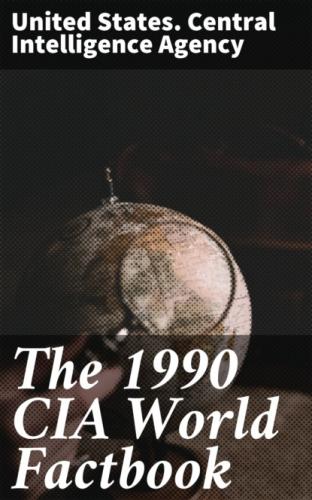Note: close to vital sea lanes through South China Sea linking Indian and Pacific Oceans; two parts physically separated by Malaysia; almost an enclave of Malaysia
- People
Population: 372,108 (July 1990), growth rate 7.1% (1990)
Birth rate: 23 births/1,000 population (1990)
Death rate: 4 deaths/1,000 population (1990)
Net migration rate: 52 migrants/1,000 population (1990)
Infant mortality rate: 10 deaths/1,000 live births (1990)
Life expectancy at birth: 74 years male, 77 years female (1990)
Total fertility rate: 2.9 children born/woman (1990)
Nationality: noun—Bruneian(s); adjective—Bruneian
Ethnic divisions: 64% Malay, 20% Chinese, 16% other
Religion: 60% Muslim (official); 8% Christian; 32% Buddhist and indigenous beliefs
Language: Malay (official), English, and Chinese
Literacy: 45%
Labor force: 89,000 (includes members of the Army); 33% of labor force is foreign (1988); 50.4% production of oil, natural gas, and construction; 47.6% trade, services, and other; 2.0% agriculture, forestry, and fishing (1984)
Organized labor: 2% of labor force
- Government
Long-form name: Negara Brunei Darussalam
Type: constitutional sultanate
Capital: Bandar Seri Begawan
Administrative divisions: 4 districts (daerah-daerah, singular—daerah);
Belait, Brunei and Muara, Temburong, Tutong
Independence: 1 January 1984 (from UK)
Constitution: 29 September 1959 (some provisions suspended under a State of Emergency since December 1962, others since independence on 1 January 1984)
Legal system: based on Islamic law
National holiday: National Day, 23 February (1984)
Executive branch: sultan, prime minister, Council of Cabinet Ministers
Legislative branch: unicameral Legislative Council
(Majlis Masyuarat Megeri)
Judicial branch: Supreme Court
Leaders:
Chief of State and Head of Government—Sultan and Prime Minister Sir Muda
HASSANAL BOLKIAH Muizzaddin Waddaulah (since 5 October 1967)
Political parties and leaders: Brunei National United Party (inactive), Anak Hasanuddin, chairman; Brunei National Democratic Party (the first legal political party and now banned) Abdul Latif bin Abdul Hamid, chairman
Suffrage: none
Elections: Legislative Council—last held in March 1962; in 1970 the Council was changed to an appointive body by decree of the sultan and no elections are planned
Communists: probably none
Member of: ASEAN, ESCAP (associate member), IMO, INTERPOL, OIC, UN
Diplomatic representation: Ambassador Dato Paduka Haji MOHAMED SUNI bin Haji Idris; Chancery at 2600 Virginia Avenue NW, Washington DC 20037; telephone (202) 342–0159; US—Ambassador Christopher H. PHILLIPS; Embassy at Teck Guan Plaza (corner of Jalan McArthur), Bandar Seri Begawan (mailing address is P. O. Box 2991, Bandar Seri Begawan); telephone p673o (2) 29670
Flag: yellow with two diagonal bands of white (top, almost double width) and black starting from the upper hoist side; the national emblem in red is superimposed at the center; the emblem includes a swallow-tailed flag on top of a winged column within an upturned crescent above a scroll and flanked by two upraised hands
- Economy Overview: The economy is a mixture of foreign and domestic entrepreneurship, government regulation and welfare measures, and village tradition. It is almost totally supported by exports of crude oil and natural gas, with revenues from the petroleum sector accounting for more than 70% of GDP. Per capita GDP of $9,600 is among the highest in the Third World, and substantial income from overseas investment supplements domestic production. The government provides for all medical services and subsidizes food and housing.
GDP: $3.3 billion, per capita $9,600; real growth rate 2.5% (1989 est.)
Inflation rate (consumer prices): 2.5% (1989 est.)
Unemployment: 2.5%, shortage of skilled labor (1989 est.)
Budget: revenues $1.2 billion (1987); expenditures $1.6 billion, including capital expenditures of NA (1989 est.)
Exports: $2.07 billion (f.o.b., 1987); commodities—crude oil, liquefied natural gas, petroleum products; partners—Japan 55% (1986)
Imports: $800 million (c.i.f., 1987); commodities—machinery and transport equipment, manufactured goods; food, beverages, tobacco; consumer goods; partners—Singapore 31%, US 20%, Japan 6% (1986)
External debt: none
Industrial production: growth rate NA%
Electricity: 310,000 kW capacity; 890 million kWh produced, 2,580 kWh per capita (1989)
Industries: petroleum, liquefied natural gas, construction
Agriculture: imports about 80% of its food needs; principal crops and livestock include rice, cassava, bananas, buffaloes, and pigs
Aid: US commitments, including Ex-Im (FY70–87), $20.6 million; Western (non-US) countries, ODA and OOF bilateral commitments (1970–87), $143.7 million
Currency: Bruneian dollar (plural—dollars); 1 Bruneian dollar
(B$) = 100 cents
Exchange rates: Bruneian dollars (B$) per US$1—1.8895 (January 1990), 1.9503 (1989), 2.0124 (1988), 2.1060 (1987), 2.1774 (1986), 2.2002 (1985); note—the Bruneian dollar is at par with the Singapore dollar
Fiscal year: calendar year
- Communications
Railroads: 13 km 0.610-meter narrow-gauge private line
Highways: 1,090 km total; 370 km paved (bituminous treated) and another 52 km under construction, 720 km gravel or unimproved
Inland waterways: 209 km; navigable by craft drawing less than 1.2 meters
Ports: Kuala Belait, Muara
Merchant marine: 7 liquefied gas carriers (1,000 GRT or over) totaling 348,476 GRT/340,635 DWT
Pipelines: crude oil, 135 km; refined products, 418 km; natural gas, 920 km
Civil air: 4 major transport aircraft (3 Boeing 757–200, 1 Boeing 737–200)
Airports: 2 total, 2 usable; 1 with permanent-surface runways; 1 with runway over 3,659 m; 1 with runway 1,406 m
Telecommunications: service throughout country is adequate for present needs; international service good to adjacent Malaysia; radiobroadcast coverage good; 33,000 telephones (1987); stations—4 AM/FM, 1 TV; 74,000 radio receivers (1987); satellite earth stations—1 Indian Ocean INTELSAT and 1 Pacific Ocean INTELSAT
- Defense Forces Branches: Royal Brunei Armed Forces, including air wing, navy, and ground forces; British Gurkha Battalion; Royal Brunei Police; Gurkha Reserve Unit
Military manpower: males 15–49, 104,398; 60,242 fit for military service; 3,106 reach military age (18) annually
Defense expenditures: $197.6 million, 17% of central government budget
(FY86)
——————————————————————————
Country: Bulgaria
